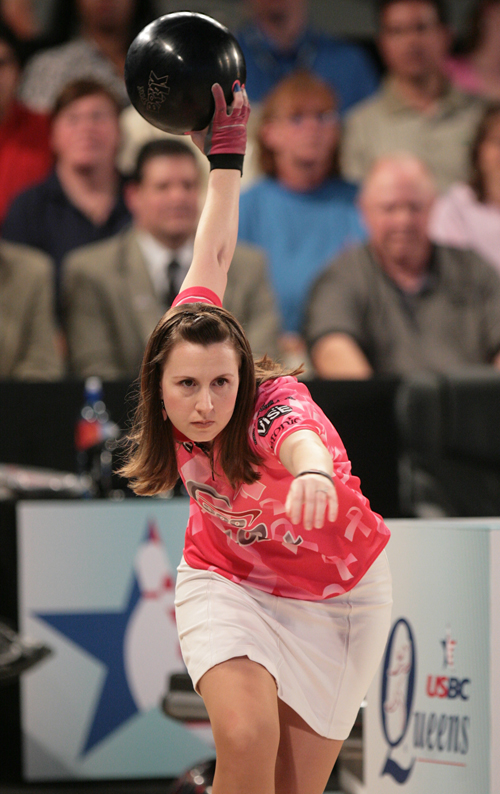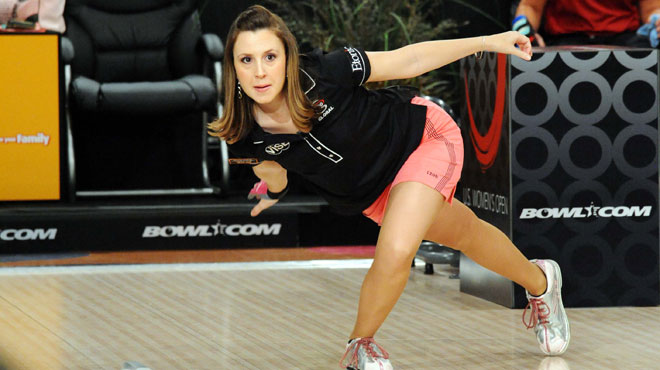Parkin looking beyond heartbreak

 Anyone who watched as it happened will not soon forget it.
Anyone who watched as it happened will not soon forget it.
When Missy Parkin of Fullerton, Calif. took the approach in the 10th frame of her match against the sport’s hottest hand in Kelly Kulick at the 2010 USBC Queens, she stood merely a mark and five pins away from moving one step closer to the women’s title she has chased for years.
“I don’t think anybody wants it worse than she does,” says her best friend and fellow pro Scott Norton. “She’s been knocking on the door for years.”
Anyone who has seen the look in Parkin’s eyes as she makes a shot knows how badly she wants it. When she stepped up to send Kulick packing that night in El Paso, she began her shot the same way she always does—by staring down her target as if she could burn a hole through the lane with her eyes.
“Missy’s a tough competitor,” says 2001 Queens champion and USBC Hall of Famer Carolyn Dorin-Ballard. “It’s never a given against Missy; you have to throw some really good shots to beat her. She always keeps the ball in play and she makes her spares.”
And keep the ball in play she did, sending it towards the pocket in what looked to be a strike or, at the very least, an easy spare leave for the win. And then, as has been the case for Parkin too many times before, what seemed like a good shot when it left her hand became a nightmare by the time it struck the pins.
Norton, sitting behind the lanes as her coach, hunched over and buried his face in his hands. Parkin’s father Frank, the former pro bowler and longtime pro shop owner whom she credits as the biggest influence in her career, winced and looked away. Drew Parkin, whom Missy would marry months later, swung his arms up over his head as if he’d been dealt a knock-out blow in a boxing match.
“A great shot. The only result that could stop her from winning,” Chris Barnes said of the pocket 7-10 split that crushed Parkin’s dreams that night.
The break was as familiar to Missy as that look in her eyes is to people who have watched her bowl. It was the same pocket 7-10 that stood between Parkin and victory against Liz Johnson at the 2007 U.S. Women’s Open, a result Marshall Holman then described as “one of the truly bad breaks in contemporary bowling,” and one that sealed her fate that day too.
“For a while I was pretty devastated,” the three-time Team USA member says of the pocket 7-10 she left at last year’s Queens. “Every time I left the 7-10 after that it was a little more frustrating than it was before then. It kind of hurt my mental game a little because I knew I bowled so well that week to make the show. It’s really tough to make the show and then have a break like that happen.”
That’s the thing about making the TV finals at a major: Those who tune in see only the game or two you bowl on TV, not the dozens of great games you bowled to get there. For a week of grueling competition to culminate in a one-and-done performance on TV is a disappointment as agonizing as the loss itself.
“I have never seen her that upset before,” says Norton, who has known Parkin since age 14. “It was pretty heart-wrenching for those of us who were there.”
But anyone who has battled Parkin on the lanes knows that she may lose now and then, but she will never be defeated. It was Liz Johnson whom Parkin bested in the finals at the U.S. Women’s Open in 2009, two years after Johnson eliminated her at that same event. A year later, Parkin sent Dorin-Ballard to the contender’s bracket at the 2010 Queens, three years after losing a PBA Women’s Series title to her at the 2007 Motor City Classic.
For Parkin, that 7-10 split is just the latest in a long line of disappointments to avenge. And if her past is any proof of what’s to come, she will not let it beat her again.
“It made me want to make my game even better,” Parkin says of the experience. “I have been working very hard on my game in the past few months, changing my ball roll to get a different axis tilt, and that’s really been helping my carry.”
That work is paying off. Parkin bowled two 300s en route to the title at a Pacific Coast Bowlers doubles tournament last month, where she and partner Norton bowled a 600 game in qualifying.

“You have to stay positive,” Parkin explains. “You can’t be like so many bowlers and say ‘Woe is me! I never carry! Woe is me! I never get good breaks!’ You have to be proactive and ask yourself why you’re not getting good carry.”
For Norton, who won his first PBA Tour title at last year's World Series of Bowling as Parkin looked on from the front row, you also have to ask yourself if you want to be great.
“The people who are remembered throughout history are the ones that can forget about it and move on and throw it just as well the next time,” he says. “I don’t care who you are, if your name is in the history books, you will have done that many times.”
But Parkin already has signed her name into those history books as the first woman to win two PBA Regional titles and the first woman to join the PBA. And if winning is any indication of the number of times a bowler has taken the gut-punch of a bad break and gotten up to throw a better shot next time, Parkin has done plenty of that, too.
“When I was growing up I won 18 girls’ titles by age 16 on the junior amateur tour, and a few people said ‘Why don’t you bowl in the boys’ division?’” Parkin recalls. “So I started bowling in the boys division and won my very first tournament. After a while they renamed it the ‘open’ division because I was winning a lot of titles against the boys.”
After all, this is the Missy Parkin who averaged 165 in a scratch league at age 10, the Missy Parkin who earned a spot on team USA before she even graduated high school—the youngest bowler to do so at the time.
And in a year when collegiate bowling boasted talent such as Bill O’Neill, Sean Rash and Ronnie Russell, it was Parkin, and not any of those stars, who won the Most Valuable Player award at the 2003 Intercollegiate Bowling Championships (now the Intercollegiate Team Championships). That year, she anchored the Cal State Fullerton team to a fourth-place finish and was voted to the All-Tournament team in the men’s division.
“She was always the first one down on the lanes practicing and the last one to leave,” says former Fullerton teammate Kristie Leong.

A spot in the history books may be enough to appease other players; but Parkin’s ambition will be satisfied only when she claims a spot among the greatest who ever took the lanes.
“Everybody knows the talent is there,” Norton says. “It’s just a matter of getting some breaks when she needs to. I think it’s starting to get to her a little bit that she hasn’t won a women’s title yet, but we all know it’s a matter of time. We all know it’s going to happen.”
“I keep telling myself my breaks will come,” Parkin says as she looks ahead to the 2011 Queens, which gets underway in Syracuse on April 22. “I know as soon as you get that first title it’s usually easier to get the next one. That snowball effect happens a lot. I know my time will come. Maybe this year, maybe next year, but hopefully sooner rather than later.”
Parkin is no stranger to the “snowball effect” she speaks of. A week after shooting her first 300 game at age 14, she did it again. Three months later, she had three perfect games to her credit, each in a different bowling center.
No one who knows her would be surprised to see Parkin wear the crown in Syracuse next week. But whenever she does chase down the title she has worked toward since that 14-year-old girl collected perfect games like coins in the bowling centers of southern California, one of the people who knows her best understands exactly what that moment will be like.
“Yeah, it’s going to be pretty emotional,” Norton says.





